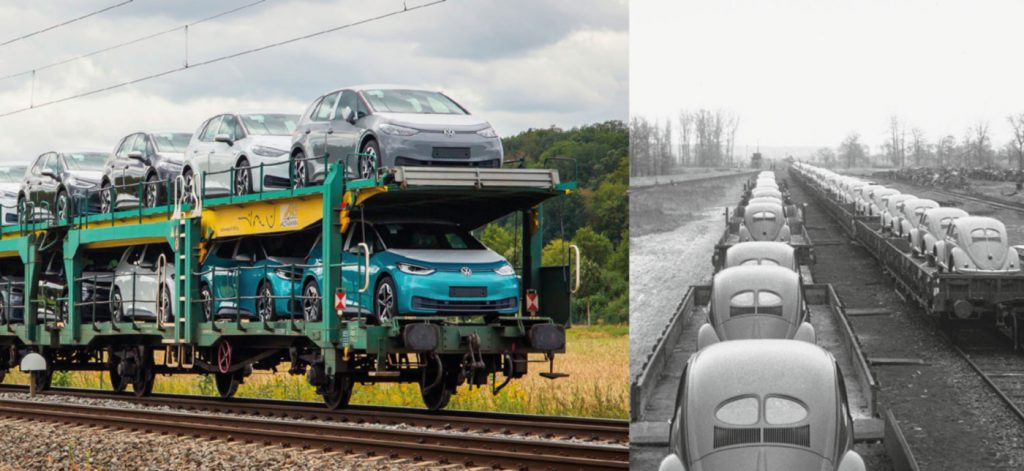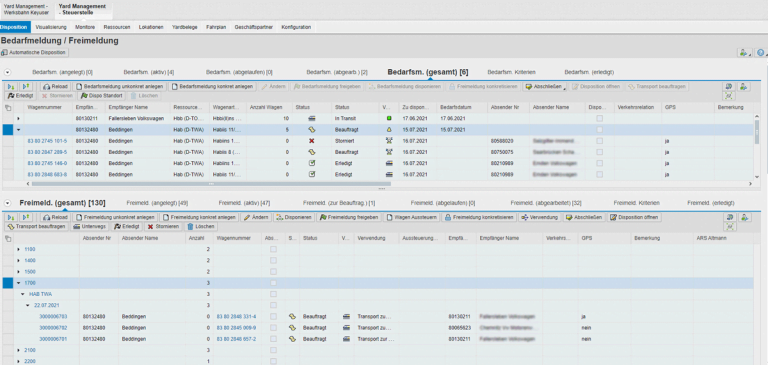How the Volkswagen Group is shaping future-proof plant rail processes together with leogistics
At the Volkswagen Group’s plant railroads, hundreds of wagons are processed in the daily inbound – no easy task for the individual locations spread across Europe. A total of up to 5 traction units are in operation simultaneously at each plant, serving up to 36 loading points. Several thousand wagon movements throughout the Group per day are the the result of this complex process. To make this even more efficient, leogistics GmbH was commissioned to introduce a modern, scalable dispatching system that would map both the loading points and the shunting teams as integral components, replace IT solutions, and at the same time be operational in line with the group-wide SAP strategy. The aim of leogistics Rail was to connect and harmonize all rail logistics at an initial eleven European locations. Today, Volkswagen is live with a digital SAP-based solution at eight VW and three Audi locations and is looking at striking process improvements.
Volkswagen Aktiengesellschaft
The Volkswagen Group, headquartered in Wolfsburg, Germany, is one of the world’s leading automakers and the largest carmaker in Europe. The company’s plants receive a large proportion of their components by rail. Around 70 percent of the finished automobiles are also transported by rail. The rail network of the Volkswagen plant in Wolfsburg alone comprises 60 kilometers of track and 152 switches.
Number of users in the operational system: 1263
Locations of plant railroads in live operation: 11
Volkswagen rolls out the leogistics Rail solution at further European locations
For the start of the project, the partners deliberately chose Braunschweig and Salzgitter, two locations with a manageable scope of functions in terms of railroad technology. Here, the initial focus was on the requirements of shunting dispatching. The aim was to gain experience for high-volume sites in this phase.
Scaling up the solution to larger locations such as Wolfsburg naturally brought with it a number of complexities within the processes and usability, where countless interactions had to be taken into account and still have to be today. After all, this is the largest private loading station in Europe. As part of an upstream parallel operation, the project team therefore ensured the smooth handling of rail transports at the Wolfsburg plant in three-shift operation as well as at the go-live on September 15, 2019, without reducing vehicle production.
After mastering this massive task, six additional locations could be switched on in quick succession. Subsequently, leogistics added the Empty Wagon Management module to the solution in order to map the cross-site empty wagon management for Volkswagen Konzernlogistik. The rollouts of two additional sites – Audi Ingolstadt and Győr – were successfully completed at the end of 2020, so that the network of legacy systems could be switched off.
"The restructuring with leogistics Rail has brought us forward in two aspects in particular: automation and transparency. Thanks to leogistics Rail, we can now collect data on wagon and empty wagon operations in an efficient and connected manner and make it directly available to all parties involved. The investment in the new software, in a connected plant railroad, is aninvestment in the future."

Volkswagen creates holistic view of rail logistics with digital solution
To meet the challenges of digitalizing operational rail processes and empty wagon management, some processes were to be consolidated. The choice fell on leogistics because the portfolio fits exactly into the existing IT strategy, reduces the number of previous solutions and thus contributes to the harmonization of the IT architecture. The integration of the leogistics Rail solution into the existing SAP transport management platform meant that there was no need to set up additional infrastructure and hardware and the project could be started immediately.
The integration and IT harmonization of the plant railroad were implemented both within the locations and across them. This step created a holistic overview of the entire rail logistics, which significantly improves cooperation within the network.
Process train arrivals, loading points and shunting orders easily via app
Today, requirements for material or empty wagons are reported without system interruption, instead of by telephone, e-mail and fax as was previously the case. Based on this, the plant railroad can plan, schedule and execute shunting orders to serve the loading points. The work of the employees on the track and their communication with the dispatcher is now also based entirely on various UI5 apps on mobile devices instead of by radio. This makes the process noticeably more transparent and efficient. For example, the now “visual communication” between dispatchers and shunting teams eliminates the acoustic influences of the rail environment.
The scrap presses now also report their requirements automatically so that empty cars are available at the right time. The same logic is behind the connected dispatch system for finished vehicles, where a shunting requirement is automatically reported to the plant railroad after completed cars have been successfully loaded onto the rail cars.
An integrated dispatching system supports the shunting dispatcher in matters of operational traction unit deployment planning and helps to achieve optimal resource deployment. Railroad undertakings (RUs) are also connected to the system via interfaces, enabling optimized dispatching across all process partners (train pre-announcement, train queuing, train status notification).

leogistics Rail creates numerous benefits
- Support and partial automation of the inbound train process for dispatchers.
- The connection of camera-based wagon recognition to the system via the integrated RailWatch solution reduces the manual effort required for the line-up check.
- Measuring stations use highly sensitive sensors and cameras to generate information about wagons, speed or wear, which is taken into account in process planning.
- By using SAP UI5 applications on mobile devices, employees on the track or on the locomotive are supported in operational processing.
- The loading point process is mapped via operating requests and linked to shunting dispatch.
- In shunting dispatching, all wagon movements are recorded and released to the locomotive shunting teams for processing via orders.
- In outbound train dispatching, all outbound wagons are collected and assigned to trains and checked before departure.
- Operational monitoring and subsequent evaluation is carried out via monitoring and reporting.
- In smaller plants or in times of low load, the plant rail operation can be carried out completely mobile, without dispatchers.
"The replacement of local legacy systems of the works railroad and theintegration of leogistics Rail into the SAP transport management platform of the Volkswagen Group both simplified the IT operating processes and created the basis for further procedural integrations of all transport management processes without cross-system interfaces."
Central Control Station facilitates empty wagon management throughout Europe
Empty wagon planning in leogistics Rail provides VW with an overview of the current and forecast stocks of wagons at all eleven locations via a central control station at Volkswagen Konzernlogistik. Surpluses and shortages are visible at a glance and the system automatically proposes a compensation for empty wagons. The integration of external locations such as workshops or purchased parts suppliers into the balancing process also has a resource-optimizing effect.
Today, Volkswagen Konzernlogistik looks forward to decisive competitive advantages thanks to the centralization of information and the consolidation of all process participants. The foundation has been laid for a future-proof, transparent and CO2-optimized plant railroad, the importance of which is steadily growing. With the support of leogistics, VW has also been able to achieve its goal of using each individual wagon economically within the group and optimizing the costs of rail operations and wagon rental.
A glimpse of the future
The new solution is now to be rolled out successively to other Group locations in order to deploy the optimized processes worldwide wherever possible. VW and leogistics are also already working together on other projects in the area of plant railroads.
A key issue for Volkswagen is the support of billing processes for rail freight. Based on the logistics data from leogistics Rail, invoices submitted by the freight forwarder are to be checked and released in SAP Transportation Management (SAP TM) largely automatically.
Work is also being done on the use of telematics and sensor data – an important advantage in rail freight transport of the future. Particularly in the area of sensitive goods such as battery cells for electric vehicles, information on temperature and any impacts to the rail cars is of great importance for transportation management, in addition to location data, in order to identify and ultimately reduce damage.

In order to be able to process such data, Volkswagen has already decided to introduce another solution from the leogistics portfolio: myleo / dsc. With the help of this, all relevant wagon information is integrated via the standard interface ITSS and the tracking solution and displayed contextually at the right time. This ensures that, given the large amount of information, only the relevant information is focused on. The integration of telematics data in leogistics Rail is the next planned step in the digitization of rail processes at VW.
"Through the trusting cooperation with leogistics, we have simultaneously sharpened and broadened the perspective on our rail logistics: On the one hand, we have been able to improve joint processes in detail and, on the other, we have taken a total European perspective. Now we are looking forward to joint future projects."
Photos © Volkswagen AG



